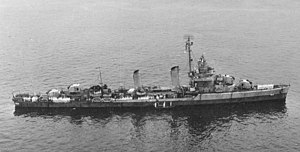
USS Wasp (CV-7) was a United States Navy aircraft carrier commissioned in 1940 and lost in action in 1942. She was the eighth ship named USS Wasp, and the sole ship of a class built to use up the remaining tonnage allowed to the U.S. for aircraft carriers under the treaties of the time. As a reduced-size version of the Yorktown-class aircraft carrier hull, Wasp was more vulnerable than other United States aircraft carriers available at the opening of hostilities. Wasp was initially employed in the Atlantic campaign, where Axis naval forces were perceived as less capable of inflicting decisive damage. After supporting the occupation of Iceland in 1941, Wasp joined the British Home Fleet in April 1942 and twice ferried British fighter aircraft to Malta.

USS Juneau (CL-52) was a United States Navy Atlanta-class light cruiser torpedoed and sunk at the Naval Battle of Guadalcanal on 13 November 1942. In total, 687 officers and sailors, including the five Sullivan brothers, were killed in action as a result of her sinking. Only 10 survivors were rescued after eight days in the water. To honor the five Sullivan brothers and Juneau, the U.S. Navy has since commissioned two ships named USS The Sullivans and two ships named USS Juneau. On 17 March 2018, Paul Allen's research crew on board RV Petrel located the wreck of Juneau at a depth of about 4,200 m (13,800 ft) off the Solomon Islands.

USS Pensacola (CL/CA-24) was a cruiser of the United States Navy that was in service from 1929 to 1945. She was the lead ship of the Pensacola class, which the navy classified from 1931 as heavy cruisers. The third Navy ship to be named after the city of Pensacola, Florida, she was nicknamed the "Grey Ghost" by Tokyo Rose. She received 13 battle stars for her service.

USS St. Lo (AVG/ACV/CVE–63) was a Casablanca-class escort carrier of the United States Navy during World War II. On 25 October 1944, St. Lo became the first major warship to sink as the result of a kamikaze attack. The attack occurred during the Battle off Samar, part of the larger Battle of Leyte Gulf.
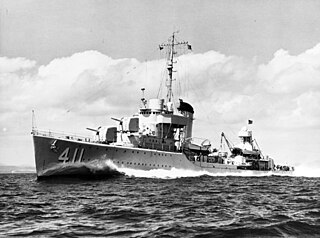
USS Anderson (DD-411) was a Sims-class destroyer in the United States Navy. She was named for Rear Admiral Edwin Alexander Anderson, Jr., a Medal of Honor recipient.

The third USS Murray (DD/DDE-576) was a Fletcher-class destroyer in the United States Navy during World War II. Murray was named for Capt. Alexander Murray and his grandson Rear Adm. Alexander Murray
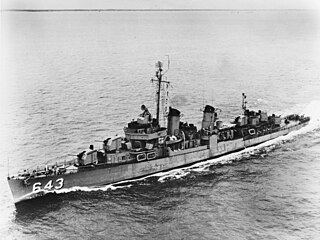
USS Sigourney (DD-643) was a Fletcher-class destroyer, the second ship of the United States Navy to be named for James Sigourney, an officer during the War of 1812.

USS Stanly (DD-478) was a Fletcher-class destroyer in service with the United States Navy from 1942 to 1947. She was scrapped in 1972.

USS Ringgold (DD-500), a Fletcher-class destroyer, was the second ship of the United States Navy to be named for Rear Admiral Cadwalader Ringgold (1802–1867). Entering service in 1942 during World War II, the destroyer served in the Pacific theater. Following the war the ship was placed in reserve before being transferred to the West German Navy and renamed Zerstörer 2 in 1959. In 1981 the destroyer was transferred to the Hellenic Navy and was renamed Kimon. Kimon was sold for scrap in 1993.

USS Converse (DD-509), a Fletcher-class destroyer, was the second ship of the United States Navy to be named for George A. Converse (1844–1909).

USS Terry (DD-513), a Fletcher-class destroyer, was the second ship of the United States Navy to be named for Commander Edward A. Terry (1839–1882).

USS Buchanan (DD-484), a Gleaves-class destroyer, was the second ship of the United States Navy to be named for Franklin Buchanan, who was an officer in the U.S. Navy who became an admiral in the Confederate Navy during the American Civil War.

USS Patterson (DD-392), a Bagley-class destroyer, was the second ship of the United States Navy to be named for Daniel Todd Patterson, an officer of the US Navy who served in the Quasi-War with France, First Barbary War, and the War of 1812.
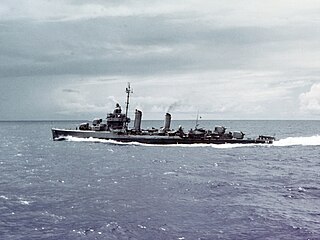
USS Edwards (DD-619) was a Gleaves-class destroyer of the United States Navy. She was the second Navy ship named "Edwards", and the first named for Lieutenant Commander Walter A. Edwards (1886–1926), who as commander of Bainbridge in 1922 rescued nearly five hundred people from the burning French transport Vinh-Long. For his heroism Edwards was awarded the U.S. Medal of Honor, the French Légion d'honneur, and the British Distinguished Service Order.

USS Lardner (DD-487), a Gleaves-class destroyer, was the second United States Navy ship to be named for Rear Admiral James L. Lardner, a Naval officer during the American Civil War. Lardner received 10 battle stars for World War II service.

USS Dyson (DD-572) was a Fletcher-class destroyer of the United States Navy. She was named for Rear Admiral Charles W. Dyson (1861–1930).
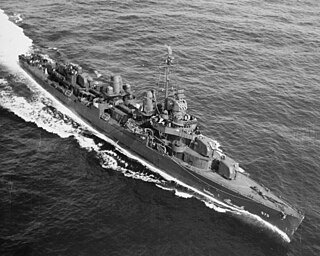
USS McKee (DD-575) was a Fletcher-class destroyer, the third ship of the United States Navy to be named for Lieutenant Hugh W. McKee.

USS Stack (DD-406) was a Benham-class destroyer in the United States Navy. She was named for Edward Stack.

USS Woodworth (DD-460) was a Benson-class destroyer in the United States Navy during World War II. She was named for Commander Selim E. Woodworth.

USS Farenholt (DD-491) was a Benson-class destroyer in the United States Navy during World War II. She was the second ship named for Admiral Oscar Farenholt.
